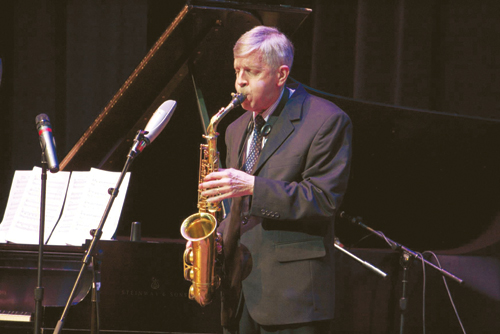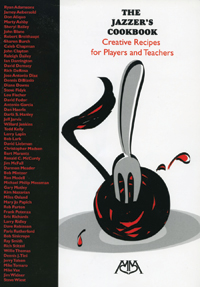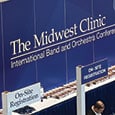
Ingredients
The ingredients are listed items that the professional jazz musician needs to have under control in order to play with confidence and make music in the jazz genre. These are not listed in any particular order. Some will take longer to master than others
Infinite boiling softens the stone. A little here and a little there will eventually get you to where you want to go. Each of us needs goals, direction, and motivation. The creative spirit within everyone demands a certain amount of effort, desire, discipline, and self-esteem. Human nature can tend to be lazy, but jazz is not a product of laziness. Jazz is creative, and creativity is energy.
Take good care of your body and mind, which are needed to achieve your goals. Don’t be misled by those whose goals are less than your own. Strive to be the best you can be.
When you begin to play music and know that you are in charge of each and every note, phrase, articulation, and sound, then you find out why it’s so much fun to play. Listen to the jazz masters and notice how much fun they are having.
The music insists that you respect all the music that has come before you. You can fool yourself and at times the listener, but you can never fool the music.
The music has been played, and played, and played. The twelve notes of the chromatic scale have been used in almost every conceivable way, but they’ve never been organized and played the way your mind will play them. Your imagination will give new shape to those twelve notes.
The vast arena of music that has come before you awaits your thoughts and your perceptions. With diligence, your instrument will convey the thoughts of your mind and the world will then have your music.
Serves
All musicians.
Memorize everything. Melodies, scales, chords, chord progressions, form, lyrics. Do this one song at a time.
Listen to original recordings of songs you want to play. Try to get inside the heads of those musicians who originally played the song. Memorize their solos.
Sightreading is important. Do some every day. Become a good sight reader.
Use your ears all the time. Listen to everything all day long. Don’t let sounds go by your ears without checking them out…was that scale dominant or diminished? What’s that pattern he just played? What type (quality) scales and chords do they use on TV, radio, etc.? Become a master of sounds. Don’t let them slip by you or you won’t be able to use them when you solo. Train your ears to hear.
As a general rule, the fourth note of major and dominant scales has a lot of tension. Learn how to use it and how to raise it a half step to create the
#4 (#11) sound that jazzers often use.
Jazz insists that you use the bebop scale. That extra note is like opening up a whole new world of possibilities. It can lengthen your lines and will instantly make you sound more professional. The C7 bebop scale is C D E F G A Bb (B) C. Don’t play the added note (B) on a downbeat.
Keyboard skills are extremely important. The visual aspect of the keyboard plus the ability to play more than one note at a time allows your mind to perceive harmony differently than playing a single-line instrument would. If you are not a keyboard player learn to use it as your most important tool. Memorize one octave in your mind. Use it mentally to solve problems and answer questions.
Listen to the bass line of jazz groups. The bass is usually the foundation and if you can hear bass you’ll have much more fun playing music the rest of your life. The bass note will affect the position of the note you play in relation to a given scale.
Sing before you play. Your voice is much closer to your musical mind than your fingers or your instrument. Sing, sing, sing. Sing out loud and mentally. Become familiar with all the intervals up to the octave. Minor and major seconds make up scales. Minor and major thirds make chords. Perfect fourths help outline chord progressions like ii / V7 and ii / V7 / I. Chords moving in 4ths are everywhere present.
Altered dominants seem to dominate the jazz vocabulary. Do you know the most used altered dominants and can you play them? Work with Volume 3 “The ii/V7/I Progression” and Volume 84 “Dominant 7th Workout” to hone your skills. Altered dominants and the bebop scale make up much of jazz players’ melodic lines.
Being able to play tunes in all twelve keys is an important part of learning the jazz language. I find that if we learn the melody and the chord progression in several keys, say three, and can improvise smoothly, the other nine keys aren’t nearly as difficult to master. It’s getting from the first key to the second and then to the third that seems to be the scariest. Once you do it to several songs or chord progressions you’ll find yourself making a habit of it and that’s when your ears will take a quantum leap in hearing and execution.
Learn to transpose if you play a transposing instrument. Song books are often in treble clef, concert key, and if you play saxophone, trumpet, or clarinet, you’ll have to transpose the notes and the chord symbols to your key.
Transcribing solos off records is important to learn pitch and rhythm recognition, shape and contour of phrases, how others build their solos, how group interaction influences note choice and rhythms, and what notes others begin and end their phrases on.
Blues. Twelve-bar blues have been around since the beginning of the 20th century. Jazz and blues go together. To a jazz musician, playing the blues doesn’t mean just playing off the blues scale. The jazz musician has added much to the history of American blues progressions and often they are quite complex. This is the natural out flowing of the creative mind mixed with desire and what we call talent.
Learn the standard blues progressions in all 12 keys. Begin slowly, stay in one key, and outline the changes. Get to where you can hear the blues progression in your sleep. Mentally hear yourself playing the blues while walking down the street. You don’t have to have your instrument to play the blues, or any tune for that matter. You can think it. Think where your fingers would be and visualize yourself making music even if you are far from your instrument.
Ballad playing usually takes more time to perfect due to the slow tempo and the exposed nature of the harmony. Also, your sound coming out of your instrument is more exposed when playing whole and half notes. Work on sound every day. Listen to the masters every day. Your sound is an important part of your musical personality. Who do you want to be? Learn a ballad in the original key and then move it up or down a half step. Stick with it until you’ve mastered the new key. Don’t leave the practice room until it’s yours. Then, tomorrow, try it again and see how long it takes to put the pieces back together again. After you do this in the new key several times your fingers will learn the new patterns and the sound of the new changes and you’ll be off and running again except now, you’ll be able to solo on the ballad in two keys instead of only one.
Strive for freedom via discipline. Use every minute of your waking day to arm yourself with the knowledge that will make you free. Think, think, think. Ask questions. Explore. Listen.
Learn “I Got Rhythm” changes in several keys. Learn turnarounds in several keys. You’ll find that what you learn is sprinkled throughout hundreds of songs and chord progressions. Volume 47 “I Got Rhythm” and Volume 16 “Turnarounds, Cycles, and ii V7s” can be a big help.
Fast playing and proper eighth note articulation have long been a feature of jazz. Concert band, marching band, pop music, etc. requires a different approach to how the notes are articulated. Listen to jazz players and you’ll find differences, but the main thing you’ll find is that their notes, when they come flying out at lickety-split tempos always have forward motion. This occurs when proper articulation is applied and your fingers are fine tuned.
Time. Play and practice in time. Use a metronome. Jazz is about time. Don’t be wishy washy with your time. Listen carefully to each note as it is played. Does it match what you’re hearing in your head? If it doesn’t, figure out why it’s off the mark. If you can’t figure it out, ask for help. Articulation is next to importance to note choice. Don’t overlook it when practicing.
Composing is an important part of musical expression. Write songs that come to your mind. Some people keep a musical notebook of their original ideas. You’ll find that what you think today can often be reshaped tomorrow into something you never dreamed could be. Don’t let original ideas for songs escape you. Write them down or play and record them. Capture them while they have life. Finalize the song and make it yours. Types of songs: bebop, swing, Latin, bossa nova, originals, ballads, odd meter, mixture of Latin and swing, free form, or free form combined with any of the above. Composing a melody and hearing it played by a competent group is quite exciting.
Inspiration seems to fill a need for musicians who are on the path of self-realization of who they really are and what their actual potential may be. We are all different and have varied goals in music and life. We receive inspiration from various sources. After September 11th, 2001, music helped to heal and quiet the mind and body of millions of people around the world.
Reading inspirational literature and hearing lectures by inspired people help bring life into focus on an individual basis. Jazz has always sought to allow the musician to express how they feel about life at any given moment. It’s very hard to express adequately on an instrument that you are only vaguely familiar with. The more control you have over your instrument the more it will allow you to express. A good instrument can be a big help.
Positive thinking plays an important role in practicing. “I think I can, I think I can” is what the little engine said as it pulled its train up the hill. Let’s keep thinking positively and reap the rewards on a daily basis.
Music is for life.
 “This article is from The Jazzer’s Cookbook: Creative Recipes for Players and Teachers and is used by Permission, Meredith Music Publications. Royalties for this project are being donated to the Jazz Education Network (JEN). To learn more, go to JazzEdNet.org.”
“This article is from The Jazzer’s Cookbook: Creative Recipes for Players and Teachers and is used by Permission, Meredith Music Publications. Royalties for this project are being donated to the Jazz Education Network (JEN). To learn more, go to JazzEdNet.org.”






